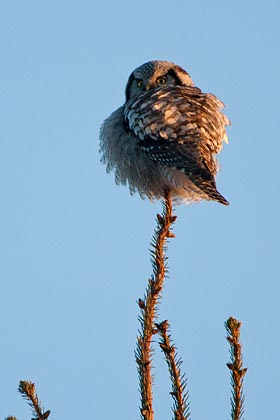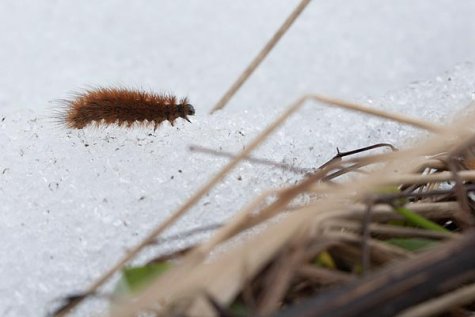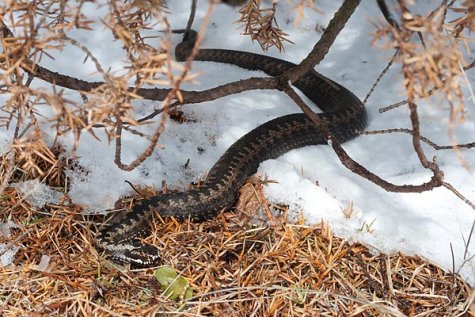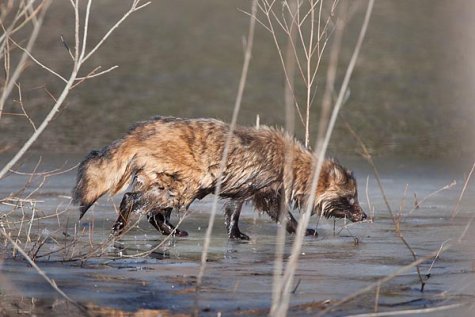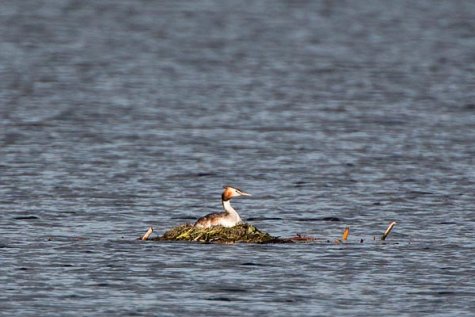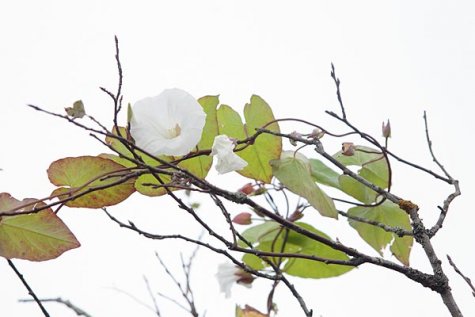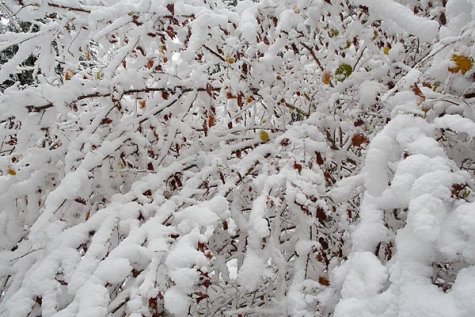Nature year 2012 – watery snake year
Text Kristel Vilbaste, loodusenaine@hot.ee
Photos Arne Ader
Translation Liis
Midwinter offered days of sharp frost: a hawk owl (Surnia ulula) from the North keeps its feathers fluffed up as protection from cold.
For me 2012 was a snake year, there was a multitude of vipers and grass snakes both in summer and in autumn. They were so many in autumn before creeping into their dens that in places people panicked. The watery water dragon’s year prepared for the beginning water snake year.
The four weather signs of the week:
Bird of the year, the partridge, outside the window,
Lynxes hunting,
Mole hills rising from the snow, and
Thaw
In days with thaw in the winter plenty of drinker moth (Euthrix potatoria) larvae could be seen on the snow.
What was special about the nature year 2012:
Gennadi Skromnov: The long-lasting beautiful autumn colours, and the high water level in our rivers where the salmonid fishes could spawn more safely.
Mikk Sarv: A year of exciting plants, in May I discovered for myself the teasel (Dipsacus sp) that cures tick borreliosis, in July we, together with the outdoors teachers, found the rampion (Phyteuma) in a Setomaa spring forest.
Rein Einasto: Our national culture must be the basis of all economy; this year the victory of Nabala made me happy, establishing the limestone quarry was suspended into an undetermined future.
Kaja Kübar: Many swans came to our fields again, showed their yellow and blue neck rings and stayed here until the snow came. There were so many cranberries in the bogs that some were still left for the third- and fourth-time-over pickers. Bear orphans have disappeared!
Enn Vilbaste: Water, water, water. As snow, water and precipitation. The corncrake has disappeared. Predator numbers have increased, the wolf raised five cubs. Bears are fewer, perhaps they have moved to Latvia, from south deer have come instead.
Urmas Tartes: For me the summer was astonishing - there were such great numbers of white admirals (Limenitis camilla), they have been very rare earlier. The beginning of winter at the end of the year was excellent for snow insects, I have never before seen so many drinker moth larvae crawling around on the snow.
Vello Keppart: I made a plant inventory of Keila city and found 14 orchid species and a spotted eagle nest, that was the greatest surprise. I also found a luminescent mycelium of the honey mushroom (Armillaria mellea) in a tree stump in the forest; I brought it home and it glowed for several weeks.
Olev Merivee: A very good cowberry (Vaccinium vitis-idaea)year.The two of us picked 35 litres in half an hour near Tõrva. The most special for me was of course seeing the pine grosbeaks in December.
Arne Ader:There were exciting meetings with the bittern (Botaurus stellaris). And at last I managed to photograph a white stork gobbling down a grass snake.
It was an dramatic snake year: viper waking up at Saluvere bank. Matsalu
January
In the beginning of January water splashed in the Pärnu beach areas, and Soomaa had a deluge. In the alder tree stand a yellow butterfly dried its wings, buds on apple trees started to open, snowdrops pushed up through the snow, in Tartu a hedgehog scuttled on the green lawn. And then frost and snow arrived with a great blizzard, put a lid on vast fields of ice. At the end of the month a 30 cm thick snow cover snowed down, flocks of waxwings arrived from the north, and snow white snowy owls also came.
February
In the beginning of February the capital of cold, Jõgeva, congealed in its -35 degrees of cold. Swans fled, flying towards south. Weasels entered houses to hunt mice, there was famine in the forest. The “hunger catkins” of alders spilled seeds on the snow so that the snow was all dotted. Regardless of the cold, great tits clamoured loudly in mid-February. But birdwatchers complained that tits had disappeared from birdfeeders. The end of the month brought thaw and the first larks.
The springtime flood was substantial. Raccoon dog, stiff from cold, on Tõramaa river ice
March
Spring arrives at huge speed, in the beginning of the month maple sap drips and snowdrops jingle. The State Forest Management Centre, RMK, admits their inability to keep walking trails in repair, due to shortage of money, the Koigi trail was left in disrepair. In the course of the year more surprises hit hikers in all corners of Estonia – Nigula, Taevaskoda... The sky was filled with skylark drills in the middle of the month, spring birds arrived at full speed. Winter still whirled up some more snowstorm clouds, but spring no longer retreated. Seal pups sailed on ice floes at sea. The end of the month brought the first hepaticas (Hepatica nobilis), some had a ladybird in the heart of the bloom.
April
Colt’s-foot flowers and then the Easter snowstorm came that divided Estonia into two halves, in the eastern half all was white. In the second week frog “weddings“ got going, the white storks were back and the black stork web camera bird laid the first snow-white egg into the nest. There were ticks and vipers in the grass, wind anemones (Anemone nemorosa)flowered. Birch sap flow was brief.
May
In the first week of May dandelions flower and the nightingale claps and drills. Snails begin with the devouring of everything living and won’t stop until autumn; 2012 was truly a snail year. In the second week a storm arose that set even the greenhouse flying. Badgers have learnt to look for food at roadsides, and at the roadsides also unusually many badger lives were left. An end of May drought, the sea warmed up to 18 degrees on the north coast.
June
The air fills with both mosquitoes and dragonflies, all that is born into the world out of water comes in huge numbers. From here onwards it only rains. Showery rains fall, no need to water the garden beds. Wild strawberries are fewer than last year, but grass straws are packed with red shield bugs. Oak leaf rollers (Tortrix viridana) eat the oaks bare. A warm and rainy Midsummer day.
Summer was characterized by the high water level in the lakes: great crested grebe (Podiceps cristatus) on its nest.
July
Hay grows chest high but it can’t be reached. Rain pours from the sky, and a real lightning period begins. There is no end to the lightning bouts. A thunder anvil cloud hangs steadily in the sky. The humidity lifts the mushroom caps up from the underforest debris. There are loads of chanterelles. At the end of July tropical heat arrives, all waters are filled with people.
August
After the heat wave the thermometer indicator drops with a thump, it is so cold outdoors that you might well put mittens on. The meteorological station warns of approaching night frosts in the second week, these, however, stay away. Partridge broods appear out of the grass and roll across the road. It is a good year for gallinaceous birds. Cowberries in the forest and cranberries in the bogs ripen exceptionally early. Gathering and picking are in fashion.
September
The rainy summer had allowed all that lived in the grass to breed well and kept them well. Suddenly they all begin to move towards the wintering places. The roads were at first full of frogs, then so many mice pressed into houses that people suspected the end of the world. As a final touch gardens were full of vipers and grass snakes. They were noted in particularly large numbers in farming villages. Earthworms fled out of the ground because it was brimming full of water. And still it rained. But the trees were beautifully coloured this year.
Early autumn was warm: after the leaf fall bindweed (Calystegia) flowers bloomed on willow branches in river meadows.
October
October was full of geese. Full as never before. Then the waxwings came, away from the frosts of the North. For unknown reasons they flew by flocks against glass windows. So many that it was talked of in Facebook, and even in the media. The end of October surprised with a snowstorm, snow fell on trees that still had large coloured leaves.
November
The snow disappeared and marsh marigolds (Caltha palustris) flowered again. Mists alternated with flights of moths. A heavy cap of humidity hung above Estonia. Plants and humans waited for snow but it did not come. Wolves snatched sheep, there was no snow, and they couldn’t be tracked.
December
Snow shock. The snow came as a powerful blizzard. For days on end no bird flew nor animal moved. Only humans tried to nudge their cars from one blizzard drift to another. For two weeks the country was besieged by a – 15 degree windy cold, by the end of the year thaw arrived.
An unforgettable snow experience came in late autumn, on October 26th airy snow fell on trees still in their autumn colours!
(Estonian orignal published 07.01.2013)

